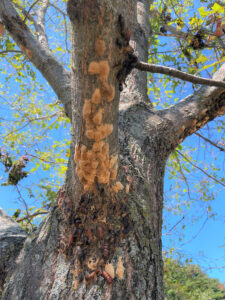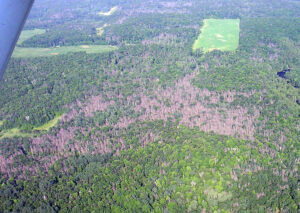
Numerous spongy moth egg masses on an oak tree in Walworth County. / Photo Credit: Bill McNee, Wisconsin DNR
By Bill McNee, DNR Forest Health Specialist, Oshkosh;
Bill.McNee@wisconsin.gov or 920-360-0942
Forest managers planning silvicultural treatments in stands susceptible to spongy moth (Lymantria dispar) – such as those containing many host species, including oak, birch, aspen and basswood – are encouraged to conduct annual egg mass surveys before treatment.
Surveys make it possible to predict if heavy defoliation is likely. If more than 30 egg masses are found in a sample area – a circle with a 37-foot diameter – then heavy defoliation is expected in the spring, and management activities should be altered or delayed until an outbreak has ended.

Map of recorded spongy moth defoliation in 2023, totaling approximately 375,000 acres. Note: Red areas are enhanced to better show small areas of defoliation. / Map Credit: Mike Hillstrom, Wisconsin DNR
Forest stands that were heavily defoliated in 2023 or are predicted to be heavily defoliated in 2024 are most likely to need a management delay or alteration. Although heavy defoliation could occur anywhere there is a favorable habitat and a well-established population, the stands with the highest risk of heavy 2024 defoliation are likely in or near areas defoliated this summer (see map).
It is recommended that a time interval be left between a stress agent (such as heavy defoliation or significant drought) and stand thinning so trees have time to recover. One growing season is a typical interval for healthy stands not subjected to drought or other stresses. A longer interval is suggested if the tree stress has been more severe or if the stand was not healthy and vigorously growing during defoliation.
The same interval is probably appropriate regardless of the stress agent. A protective aerial spray may prevent tree stress from defoliation but is usually not economically viable due to cost.
Trees Can Recover
Healthy hardwoods usually tolerate one or two years of heavy defoliation if that is the only tree stress. Susceptible trees with good crown condition (less than 25% dead branches) are much more likely to survive heavy defoliation than trees with poor crown condition (more than 50% dead branches). Young regeneration (seedlings, sprouts and saplings) is susceptible to defoliation and mortality, even in clearcuts and other open areas.

A 2005 aerial photo of heavy oak mortality in Marinette County. Oaks in this area had been defoliated in 2002 while drought-stressed and overmature. / Photo Credit: Bill McNee, Wisconsin DNR
Recent egg mass observations and adult moth trap catches predict a continuing outbreak (high population period) during summer 2024 in many previously impacted areas. It is also likely to see expansion into other areas not defoliated in 2023. Very unfavorable weather conditions (an extended period of bitter cold this winter or a cold and rainy spring) would reduce populations or bring the outbreak to an end.
Wisconsin’s highest spongy moth populations and most intense forest defoliation incidents have been seen at sites with sandy soil and abundant northern pin (scrub) or black oak. Ridgetops and south-facing slopes with abundant oak are also highly susceptible to defoliation and mortality.
Spongy moth outbreaks can become intense in locations such as central Marinette County, the Legend Lake area of Menominee County, the ridgetops of the Bayfield Peninsula and the Driftless Area when the weather conditions are highly favorable for the insect. Previous Wisconsin outbreaks have lasted one to three years at a single location.
Survey Is Best Predictor
An egg mass survey is the best way to predict defoliation next summer. Spongy moth egg masses, tan-colored lumps about the size of a nickel or quarter, are found on trees, buildings and other outdoor objects. Egg masses produced in 2023 will feel firm and appear darker in color than older egg masses that do not contain viable eggs.
An older silviculture guide for spongy moths is available for foresters looking to prepare stands for future spongy moth defoliation or address impacts from the existing outbreak. Most of the recommendations are still valid. However, the arrival of emerald ash borer has meant that ash is no longer recommended for increasing species diversity in a stand. An update of these silviculture recommendations is in progress.
Visit spongymoth.wi.gov for additional information about the insect and its management in urban and rural forests. For further assistance, contact a DNR Forest Health Specialist.
